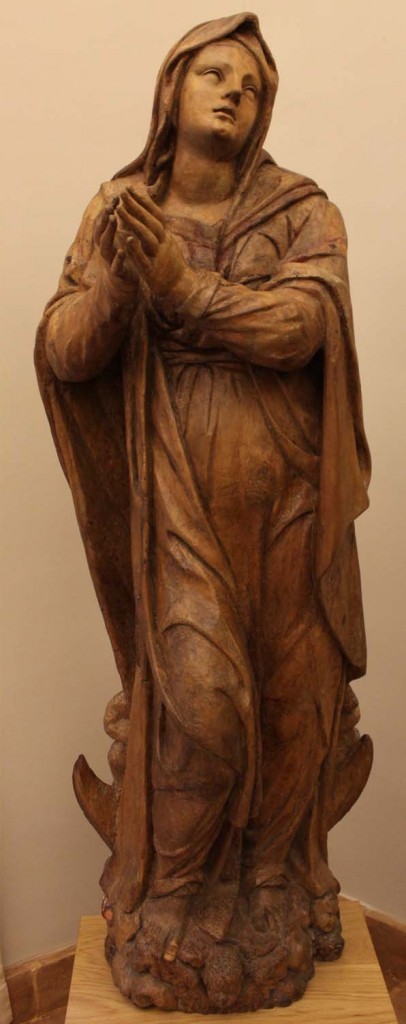 In the rich heritage of artistic works kept in the house and the Church of Mary Magdalene, the wooden statue portraying the Immaculate Mary occupies a position of primary importance. This valuable image, which was probably produced during the second half of the sixteenth century, is pro-foundly linked to the history of the Ministers of the Sick (the Camillians). Indeed, tradition has it that it was specifically in front of this statue of the Immaculate Mary that St. Camillus and his first companions pronounced their solemn vows on 8 December 1591
In the rich heritage of artistic works kept in the house and the Church of Mary Magdalene, the wooden statue portraying the Immaculate Mary occupies a position of primary importance. This valuable image, which was probably produced during the second half of the sixteenth century, is pro-foundly linked to the history of the Ministers of the Sick (the Camillians). Indeed, tradition has it that it was specifically in front of this statue of the Immaculate Mary that St. Camillus and his first companions pronounced their solemn vows on 8 December 1591
This very beautiful work portrays, in almost life-like size, the Virgin standing at prayer with her hands crossed, one knee slightly bent and her head slightly inclined to one side. Her feet rest on little clouds from which emerge the faces of winged putti and behind the figure of the Virgin there is a half-moon, the symbol of chastity and purity. The refined features of the face and the exquisite shaping of the model might lead one to think that this comes from the school of Michelangelo, even though over time different hypotheses have been made as regards the attribution of its authorship. In the records of the superintendence of Rome it is catalogued as a work attributed to Alessandro Ventura (1525-1608), a pupil of Sansovino.
This very beautiful work portrays, in almost life-like size, the Virgin standing at prayer with her hands crossed, one knee slightly bent and her head slightly inclined to one side. Her feet rest on little clouds from which emerge the faces of winged putti and behind the figure of the Virgin there is a half-moon, the symbol of chastity and purity. The refined features of the face and the exquisite shaping of the model might lead one to think that this comes from the school of Michelangelo, even though over time different hypotheses have been made as regards the attribution of its authorship. In the records of the superintendence of Rome it is catalogued as a work attributed to Alessandro Ventura (1525-1608), a pupil of Sansovino.
The statue was at the outset polychrome but must over time have been much damaged and this completely eliminated the plaster and the original pictorial covering. Albeit in the absence of documents, it is possible to suggest that the first and most important damage to the stature took place in 1598 when one of the most devastating floods caused by the Tiber filled the Church of Mary Magdalene to the top of the high altar, which was, in-deed, located higher than the side altars. Father Amici refers to a ‘praiseworthy intervention involving repair and decoration’ carried out on the stature of the Immaculate Mary during the course of the eighteenth century. More recently, this work was the object of restoration work in 1968, during which the various layers of plaster and additional painting which covered the whole image were re-moved, thus bringing out the wooden essence of the work.
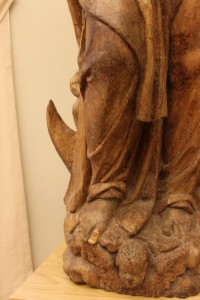 Today, on the occasion of the birth of museum dedicated to St. Camillus in the house of Mary Magdalene, the work is being subjected to new but light restoration work which seeks more than any-thing else to improve its state of conservation. Forty years after the previous work, there had emerged, in fact, a certain weakening of the wood fibres due to temperature changes, damp, and at-tacks by wood-eating insects. The wood core of the stature is thus being subjected to treatment de-signed to counter woodworm and to strengthen the whole of the structure through the injection of acrylic resins. A thick patina of dust and organic dirt (smoke, grease) covered the whole of the statue and this has been removed with a light solution of water and ammonia. From an aesthetic point of view as well, the numerous dents, abrasions and traces left behind by woodworms have been re-moved so that one can enjoy in a less fragmentary way the sight of such a valuable artistic production.
Today, on the occasion of the birth of museum dedicated to St. Camillus in the house of Mary Magdalene, the work is being subjected to new but light restoration work which seeks more than any-thing else to improve its state of conservation. Forty years after the previous work, there had emerged, in fact, a certain weakening of the wood fibres due to temperature changes, damp, and at-tacks by wood-eating insects. The wood core of the stature is thus being subjected to treatment de-signed to counter woodworm and to strengthen the whole of the structure through the injection of acrylic resins. A thick patina of dust and organic dirt (smoke, grease) covered the whole of the statue and this has been removed with a light solution of water and ammonia. From an aesthetic point of view as well, the numerous dents, abrasions and traces left behind by woodworms have been re-moved so that one can enjoy in a less fragmentary way the sight of such a valuable artistic production.
The statue will be placed in one of the most important rooms of the museum, adjacent to the Cubiculum, to offer all those people who visit it an opportunity to admire and venerate an artistic work of great worth, but also one of the most important symbols of the Christian Faith.
Cristiana Maria Noci Francesca Piat









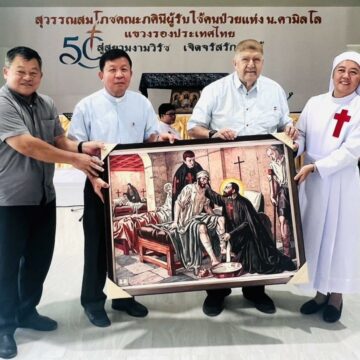
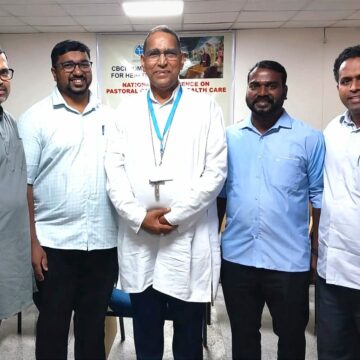


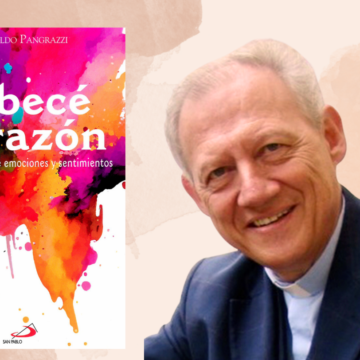
Camillians on Facebook
Camillians on Twitter
Camillians on Instagram